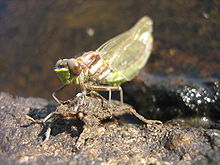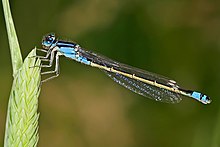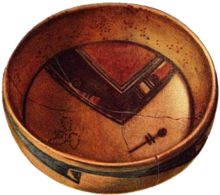| Dragonfly | |
|---|---|
 | |
| Yellow-winged Darter | |
| Scientific classification [ e ] | |
| Kingdom: | Animalia |
| Phylum: | Arthropoda |
| Class: | Insecta |
| Order: | Odonata |
| Suborder: | Epiprocta |
| Infraorder: | Anisoptera Selys, 1854 |
| Families | |
Dragonflies are valuable predators that eat mosquitoes, and other small insects like flies, bees, ants, and very rarely butterflies. They are usually found around lakes, ponds, streams and wetlands because their larvae, known as "nymphs", are aquatic.
Contents |
Etymology
Anisoptera comes from the Greek an meaning not, iso meaning equal, and ptera meaning wings. Their hind wings are broader than their fore wings.Life cycle

Pair of Yellow Striped Hunters mating
The larval stage of large dragonflies may last as long as five years. In smaller species, this stage may last between two months and three years. When the larva is ready to metamorphose into an adult, it climbs up a reed or other emergent plant. Exposure to air causes the larva to begin breathing. The skin splits at a weak spot behind the head and the adult dragonfly crawls out of its old larval skin, pumps up its wings, and flies off to feed on midges and flies. In flight the adult dragonfly can propel itself in six directions; upward, downward, forward, back, and side to side.[4] The adult stage of larger species of dragonfly can last as long as five or six months.
Classification (Anisozygoptera)
Formerly, the Anisoptera were given suborder rank beside the "ancient dragonflies" (Anisozygoptera) which were believed to contain the two living species of the genus Epiophlebia and numerous fossil ones. More recently it turned out that the "anisozygopterans" form a paraphyletic assemblage of morphologically primitive relatives of the Anisoptera. Thus, the Anisoptera (true dragonflies) are reduced to an infraorder in the new suborder Epiprocta (dragonflies in general). The artificial grouping Anisozygoptera is disbanded, its members being largely recognized as extinct offshoots at various stages of dragonfly evolution. The two living species formerly placed there — the Asian relict dragonflies — form the infraorder Epiophlebioptera alongside Anisoptera.Flight speed
Tillyard claimed to have recorded the Southern Giant Darner flying at nearly 60 miles per hour (97 km/h) in a rough field measurement.[5] However, the greatest reliable flight speed records are for other types of insects.[6] In general, large dragonflies like the hawkers have a maximum speed of 10–15 metres per second (22–34 mph) with average cruising speed of about 4.5 metres per second (10 mph).[7]Dragonflies and damselflies
Damselflies (suborder Zygoptera), typically being smaller than dragonflies, are sometimes confused with newly moulted dragonflies. However, once a dragonfly moults, it is already fully grown. There are other distinctions that set them apart: most damselflies hold their wings at rest together above the torso or held slightly open above (such as in the family Lestidae), whereas most dragonflies at rest hold their wings perpendicular to their body, horizontally or occasionally slightly down and forward. Also, the back wing of the dragonfly broadens near the base, caudal to the connecting point at the body, while the back wing of the damselfly is similar to the front wing. The eyes on a damselfly are apart; in most dragonflies the eyes touch. Notable exceptions are the Petaluridae (Petaltails) and the Gomphidae (Clubtails).The largest living odonate by wingspan is actually a damselfly from South America, Megaloprepus caerulatus (Drury, 1782) while the second largest are females of the dragonfly Tetracanthagyna plagiata (Wilson, 2009). The female T. plagiata is probably the heaviest living odonate.[8]
Common species
Northern hemisphere
|
|
Southern hemisphere

A Tau Emerald (Hemicordulia tau) in mid flight
- Glistening Demoiselle Phaon iridipennis
- Dancing Jewel Platycypha caligata
- Mountain Malachite Chlorolestes fasciatus
- Common Spreadwing Lestes plagiatus
- Common Threadtail Elattoneura glauca
- Goldtail Allocnemis leucosticta
- Swamp Bluet Africallagma glaucum
- Pinhey's Whisp Agriocnemis pinheyi
- Black-tailed Bluet Azuragrion nigridorsum
- Common Citril Ceriagrion glabrum
- Yellow-faced Sprite Pseudagrion citricola
- Gambel's Sprite Pseudagrion gamblesi
- Hagen's Sprite Pseudagrion hageni
- Hamon's Sprite Pseudagrion hamoni
- Kersten's Sprite Pseudagrion kersteni
- Masai Sprite Pseudagrion massaicum
- Powdered Sprite Pseudagrion spernatum
- Orange Emperor Anax speratus
- Common Thorntail Ceratogomphus pictus
- Southern Yellowjack Notogomphus praetorius
- Ivory Pintail Acisoma trifidum
- Banded Groundling Brachythemis leucosticta
- Broad Scarlet Crocothemis erythraea
- Little Scarlet Crocothemis sanguinolenta
- Black Percher Diplacodes lefebvrii
- Black-tailed False-skimmer Nesciothemis farinosa
- Two-striped Skimmer Orthetrum caffrum
- Epaulet Skimmer Orthetrum chrysostigma
- Julia Skimmer Orthetrum julia
- Navy Dropwing Trithemis furva
- Kirby's Dropwing Trithemis kirbyi
- Jaunty Dropwing Trithemis stictica
Dragonflies in cultures
In Europe, dragonflies have often been seen as sinister. Some English vernacular names, such as "devil's darning needle" and "ear cutter", link them with evil or injury.[9] A Romanian folk tale says that the dragonfly was once a horse possessed by the devil. Swedish folklore holds that the devil uses dragonflies to weigh people's souls.[10]:25–27 The Norwegian name for dragonflies is "Øyenstikker", which literally means Eye Poker and in Portugal they are sometimes called "Tira-olhos" (Eye snatcher). They are often associated with snakes, as in the Welsh name gwas-y-neidr, "adder's servant".[9] The Southern United States term "snake doctor" refers to a folk belief that dragonflies follow snakes around and stitch them back together if they are injured.[11]For some Native American tribes they represent swiftness and activity, and for the Navajo they symbolize pure water. Dragonflies are a common motif in Zuni pottery; stylized as a double-barred cross, they appear in Hopi rock art and on Pueblo necklaces.[10]:20–26
They also have traditional uses as medicine in Japan and China. In some parts of the world they are a food source, eaten either as adults or larvae; in Indonesia, for example, they are caught on poles made sticky with birdlime, then fried in oil as a delicacy.[9]
In the United States dragonflies and damselflies are sought out as a hobby similar to birding and butterflying, known as oding, from the dragonfly's Latin species name, odonata. Oding is especially popular in Texas, where a total of 225 species of odonates in the world have been observed. With care, dragonflies can be handled and released by oders, like butterflies.[12]
Images of dragonflies are common in Art Nouveau, especially in jewelry designs.[13] They also appear in posters by modern artists such as Maeve Harris.[14] They have also been used as a decorative motif on fabrics and home furnishings.[15]
Japan
As a seasonal symbol in Japan, the dragonfly is associated with late summer and early autumn.[16]More generally, in Japan dragonflies are symbols of courage, strength, and happiness, and they often appear in art and literature, especially haiku. The love for dragonflies is reflected in the fact that there are traditional names for almost all of the 200 species of dragonflies found in and around Japan.[17] Japanese children catch large dragonflies as a game, using a hair with a small pebble tied to each end, which they throw into the air. The dragonfly mistakes the pebbles for prey, gets tangled in the hair, and is dragged to the ground by the weight.[10]:38
As it symbolizes courage, boys are given the name of "Tombo", meaning dragonfly. The shape of the archipelago of Japan, as seen on a map, is said to be that of a dragonfly. Hence the leading male character in Kiki's Delivery Service, in a non-Japanese setting, is named "Tombo" so that the Japanese audience can identify with him.
Beyond this one of Japan's former names – あきつしま (Akitsushima) – is literally an archaic form of Dragonfly Island(s).[18] This is attributed to a legend in which Japan's mythical founder, Emperor Jinmu, was bitten by a mosquito, which was then promptly eaten by a dragonfly.[19][20]







No comments:
Post a Comment